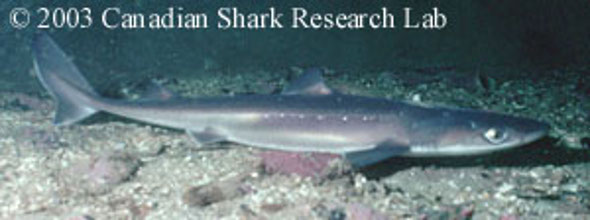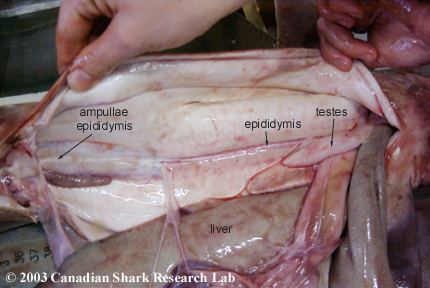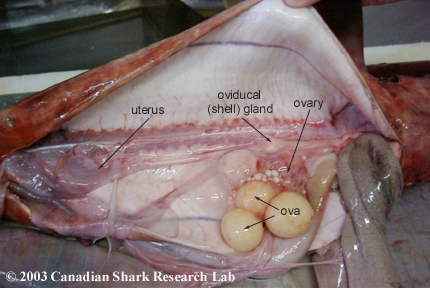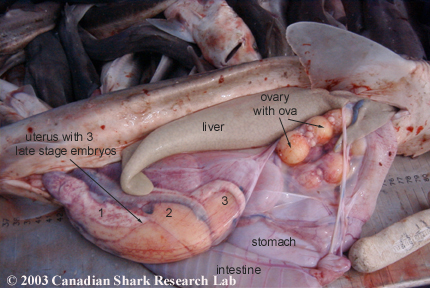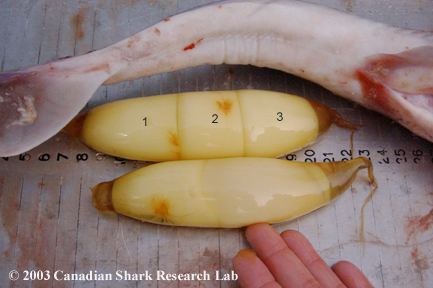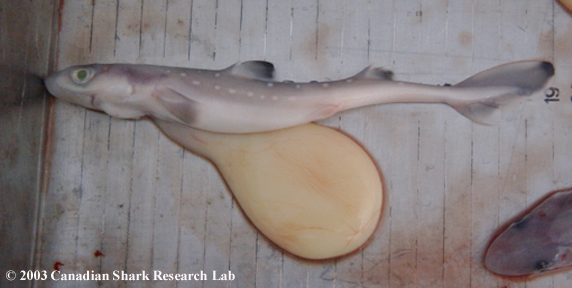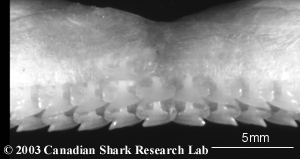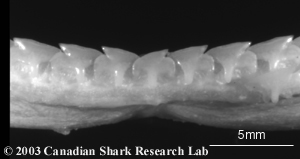Spiny Dogfish
Description
The spiny dogfish is a small schooling shark that forms groups of hundreds or thousands of individuals of the same sex and size. It is one of the most abundant demersal shark species. This shark is gray or brownish on top and pale gray or white on its ventral side with irregular white spots on the top or sides of the body. The second dorsal fin is smaller than the first and both fins have spines at their origin. The caudal fin is asymmetrical with the upper lobe being larger. The smooth edged short and oblique teeth are similar in both the upper and lower jaw.
Range
This shark is present in all of the worlds temperate oceans It ranges throughout the coastal waters of the Atlantic and Pacific oceans. The spiny dogfish can be either a resident or a seasonal migrant into Canadian waters. Most of the dogfish in Canadian waters move inshore in the summer and offshore in the winter, but remain in Canadian waters. Semi-resident aggregations occur off southern Newfoundland, in the Gulf of St Lawrence and on the Scotian Shelf off Nova Scotia. However, 10-20% of the dogfish around southwest Nova Scotia move south into U.S. waters each fall, returning in the spring. The species is most abundant between Nova Scotia and Cape Hatteras.
Habitat
The spiny dogfish is found in cold and warm temperate oceans at temperatures between 0 and 15 degrees Celsius. However on the Scotian Shelf, this shark has most often been caught in water temperature between 6 and 11 degrees Celsius. The spiny dogfish is tolerant of a wide range of salinities and can be found in estuaries. It can be located in the water column from the surface to depths of 730 meters (2,400 feet).
Life History
The average adult length is between 75 and 105 cm (30 to 40 inches), however individuals have been known to grow to 130 cm (50 inches) weighing 9 kg (20lbs). The spiny dogfish is long lived and slow growing and has an estimated life span of 30 to 40 years. Ages as old as 70 years have been determined for dogfish off British Columbia. Tagging studies have determined that some spiny dogfish can migrate great distances. Individuals tagged off of Newfoundland have been recovered in Iceland years later. There have also been records of transatlantic crossings. However the bulk of the population migrates inshore/offshore or along the northeastern coast of North America on a seasonal basis.
Diet
The spiny dogfish is an omnivorous opportunistic feeder eating whatever prey is abundant. In general their diet is comprised of small fishes such as capelin, cod, haddock, hake, herring, menhaden and ratfish. They also eat invertebrates such as krill, crabs, polychaete worms, jellyfish, ctenophores, amphipods, squid and octopus.
Reproduction
Development in this shark is ovoviviparous. The gestation length is the longest known for sharks at an estimated 18-22 months. Young are born in the warmer waters off of the northeastern U.S. and Nova Scotia during the winter months. The number of young born in a litter is dependant on the size of the female, larger females bearing more pups. However most litters are between 1 and 14 individuals that are approximately 20 to 30 cm in length. The average litter is 5-6 pups. Sexual maturity in males is reached at a total length of about 64 cm and 10 years of age. Females reach sexual maturity at a later age, around 16 years, at which time they are about 82 cm in total length. Reproduction occurs offshore in the winter.
The images below show the internal organs of mature dogfish and stages of embryo development. (Note: these are high resolution images, so the images will take somewhat longer to display).
Interaction with People
The spiny dogfish is a major predator on some commercially important species such as herring, Atlantic mackerel and squid. It has been harvested for the last 100 years for its oil rich liver which was used in lamp oil and machine lubricants. The oil was later used as a source of vitamin A. Today spiny dogfish is valued as food in many countries. The spiny dogfish is the target of a directed fishery in Atlantic Canada, and has been the subject of considerable research in our laboratory.
Distinguishing Characteristics
- No anal fin
- Spines in front of each dorsal fin
- Strongly oblique teeth in both jaws, with single cusp
- No subterminal notch on caudal fin
- Pectoral fins with curved rear margins
- Narrow anterior nasal flap
